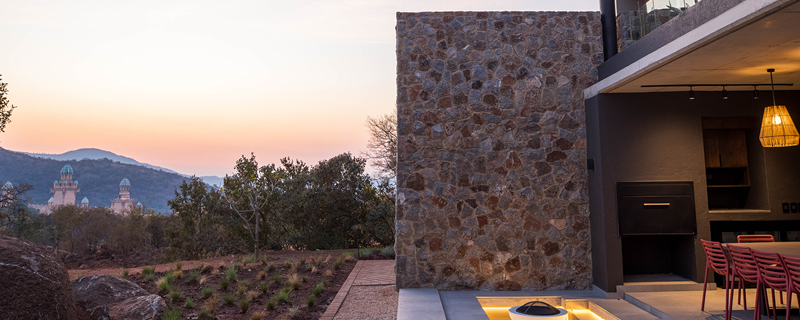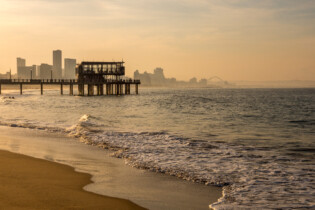A year into development, the luxurious high-end Lefika Villas development at Sun City is 85% complete and will be ready to host guests for the 2023 Nedbank Golf Challenge.
Sun City resort general manager, Brett Hoppe, says, “The development could not have come at a more opportune moment. With the Nedbank Golf Challenge starting on 6 November and the end of year holidays fast approaching, we are facing unprecedented demand. Luckily all ten of the four-bedroom villas and 65% of the three-bedroom Villas will be available from November. The remaining villas will come on board by mid-December, just in time for festive season bookings.”
“[W]e are facing unprecedented demand.”
The villas are all already fully booked for Christmas and New Year.
Sun International’s R295-million development consists of 48 three-bedroom and 10 free standing, four-bedroom villas, all en-suite. The new luxury villas form the first phase of a 5-star plus timeshare for the Sun Vacation Club, with a club house, new restaurants, and other amenities to follow. Since its inception in 1996, the Sun Vacation Club has grown to become one of the leading self-catering accommodation offerings in South Africa, selling luxury units on a 5- or 10-year rotating holiday club membership basis.
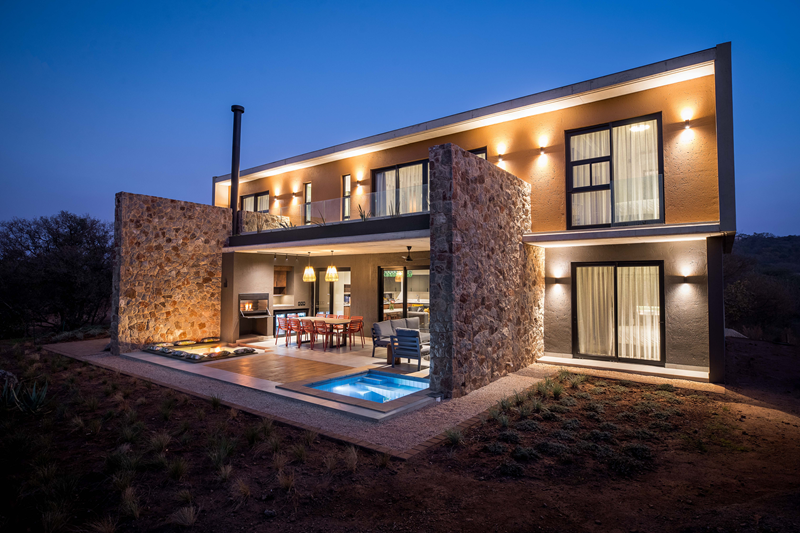
Janita Donaldson, group general manager for the Sun Vacation Club, says, “We realised that the demand for high-end luxury accommodation was there, but the market reaction to the development exceeded all of our expectations and outstripped our sales predictions. By September this year, 11 months after our sod-turning, our entire four-bedroom stock has been sold and the pace of sales for the three-bedroom villas is also tracking way above expectation. Reservations opened on 5 October 2023 and that same day, we received reservations from 22% of our members. More than 50% of the four-bedroom villas were also booked for the next 12 months.”
Janita adds that 40% of Lefika Villas sales were by existing Sun Vacation Club members, while the remaining 60% was bought by new members.
Lefika Villas construction and design
Lefika means ‘stone’ in Setswana, the local language, and the name pays homage to the adjacent stone-walled Itlholanoga heritage site – the real ‘Lost City’ of the greater Sun City resort.
Boogertman + Partners architectural team manager, Lila Gouws, says, “The expansive mountain views from the villas evoke a feeling of being in nature, built in the trees on a mountainous site, overlooking the valley below, with design inspiration generated from the local flora and fauna.”
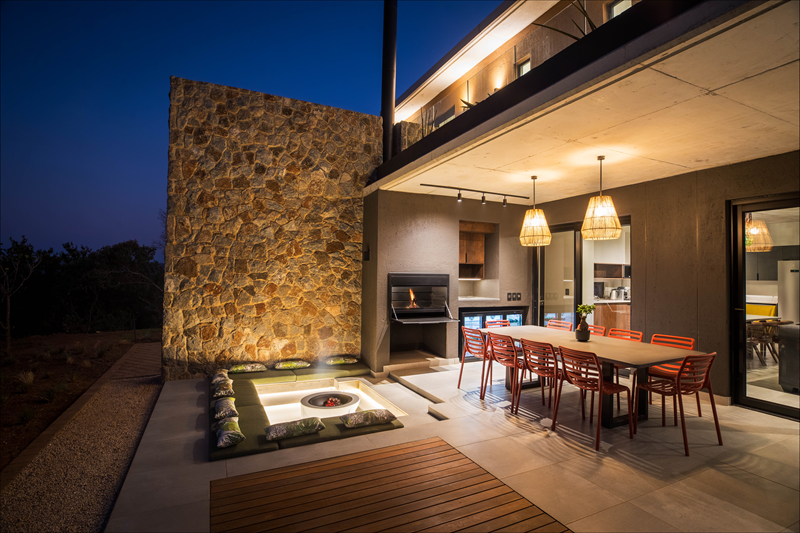
Lila hiked the site for two days with landscape architect Mariska Els to gain an intimate understanding of the environment and available space. She explains that natural features, such as rocky outcrops and large trees, determined where the villas was placed, done in a way that ensured each one of them has unobstructed views and absolute privacy.
“Our contemporary South African interpretation adopted a very bespoke approach to the site and there are many elements which have been specifically custom designed for the project.”
“Our contemporary South African interpretation adopted a very bespoke approach to the site and there are many elements which have been specifically custom designed for the project,” adds Lila.
“The natural environment was used as a driving factor in all decisions and influenced the colour and material palette; from the external natural stone walls to the interior art, soft furnishings, cutlery and crockery, creating a unique and truly contextual aesthetic.”
In total, a team of 15 architects and designers from Boogertman + Partners and Boogertman Interiors Turnkey spent the past 18 months designing and supervising the construction of the villas. They also procured furniture and fixtures for the building, landscape, and the interiors.
Local is lekker
Lila says, “We used very site-specific natural materials in the design and procurement process – natural stone from the site for the walls, concrete tables, dark wood to emulate bark of the trees, blown glass, timber beads, felt and jute in the interiors. The result is a space which is peaceful and immersed in nature, where you can relax with family and friends.”
Artworks, furniture, surface finishes and lighting by local artists were prioritised, while the crafts and cultural heritage from the North West Province – including weaving and bead work – are also proudly on display.
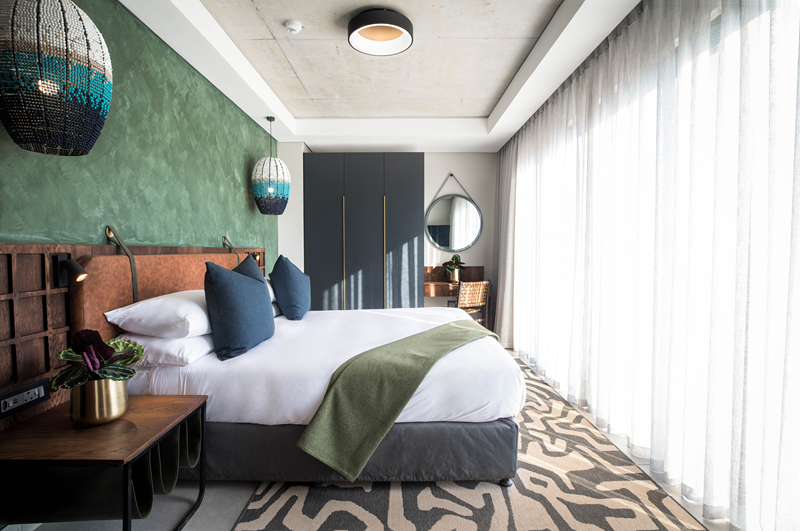
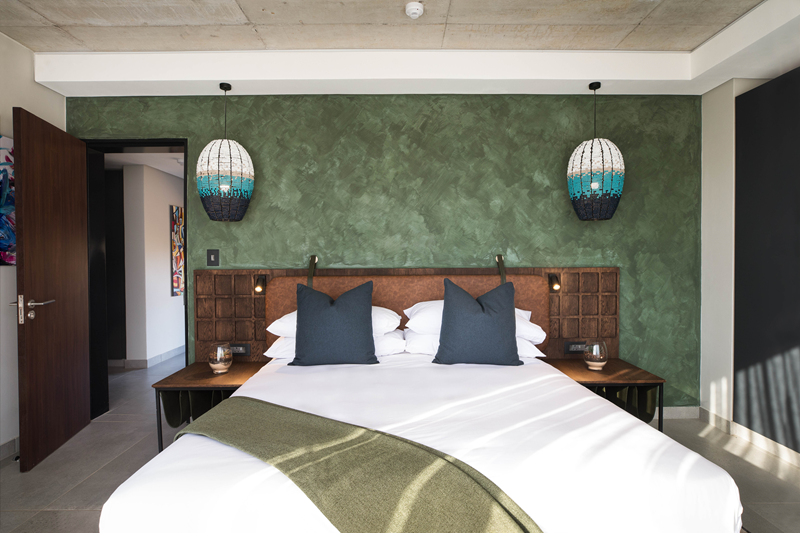
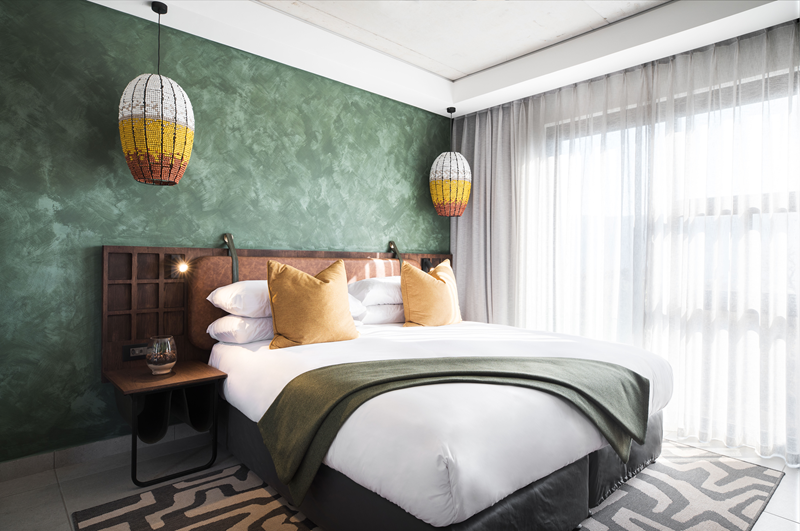
Unique pendant lights hanging in the staircases and bathrooms were made from handblown glass by Glass Forming Academy, while the bead chandeliers in the dining rooms and bedrooms are by MASH-T. These are just two of the many features which cannot be bought off-the-shelf, and which celebrate South Africa’s local artistry.
“Durban artist Karla Nixon, who works with shredded paper, was commissioned to create an abstract interpretation of the mountains in the colours of the African sunset,” adds Lila. The work is almost 2 m in length and will hang in the Lefika Villas reception area. Other fine artists whose work has been used include Sanmarie Harms, Mandisi Mncela, Sue Martin, Balekane Legoabe, Lara Kruger, Lesego Moncho, and Sera Holland.
Lila’s team also created a beautiful one-of-a-kind wallpaper using the local mountain range as a backdrop, with a spectacular graphic of local aloes and the Lefika Villas’ stone pattern.
Designed with everyone in mind
Meanwhile, two of the three-bedroom villas have been designed for the mobility impaired, custom-made to be wheelchair-friendly, with grab handles and height of basins adapted. “There are also emergency buttons within the villas to call should assistance be required,” notes Lila.
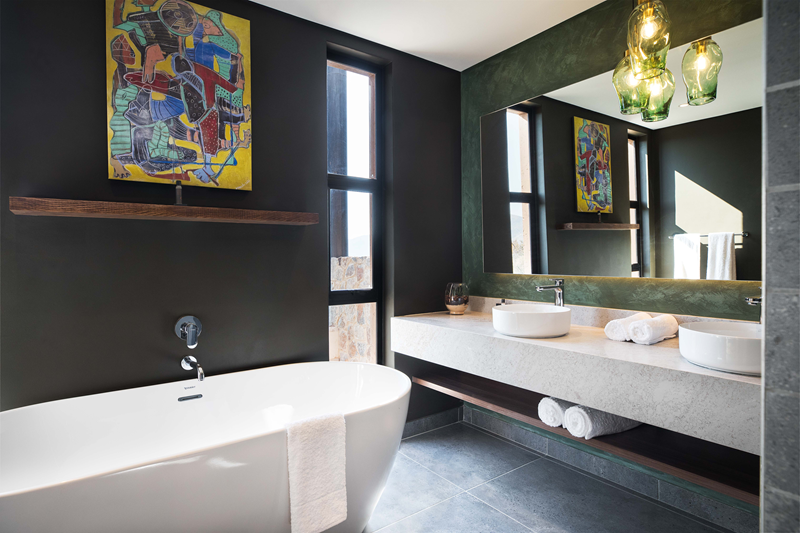
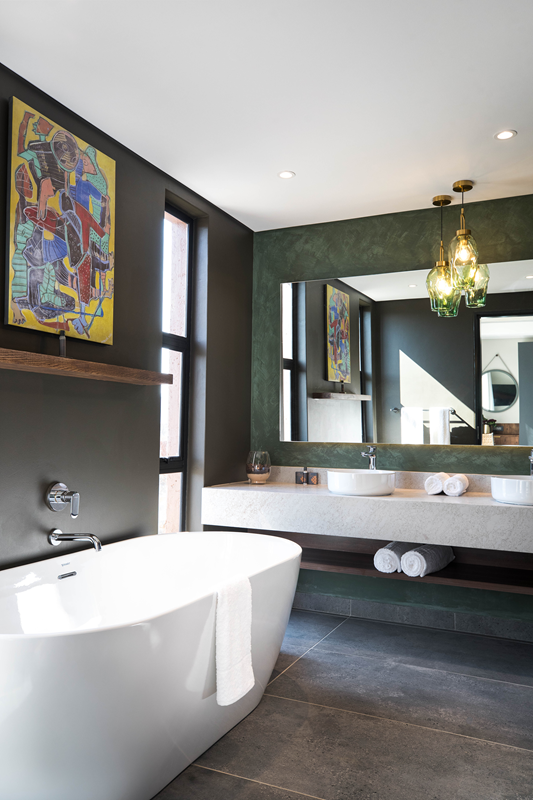
All villas have a closed combustion fireplace, and an outdoor entertainment deck with braai and entertainment area. The four-bedroom villas also have their own private plunge pool, and a fire pit to gather around for star gazing and late-night chats.
Wide sidewalks connect Lefika Villas to the main Resort, and the bus stop is five minutes away, connecting members to the various attractions and amenities at Sun City.
Keeping it clean and green
Green design principles were also implemented in the building of Lefika Villas.
Passive design principles make the villas energy friendly, reducing heat gain in summer and heat loss in winter. These include ideal orientation, thick stone walls which keep the day’s heat out and create warmth at night, maximised natural light, thermal insulation to underside floors and on top of roof slabs, and large overhangs.
Large glazed areas also allow for ample natural lighting, while strategically placed windows create effective cross ventilation and an ideal level of comfort. Water saving sanitary fittings with energy efficient cold start taps, heat pumps for effective water heating, and the use of LED lightings all contribute to the energy efficiency of the villas.
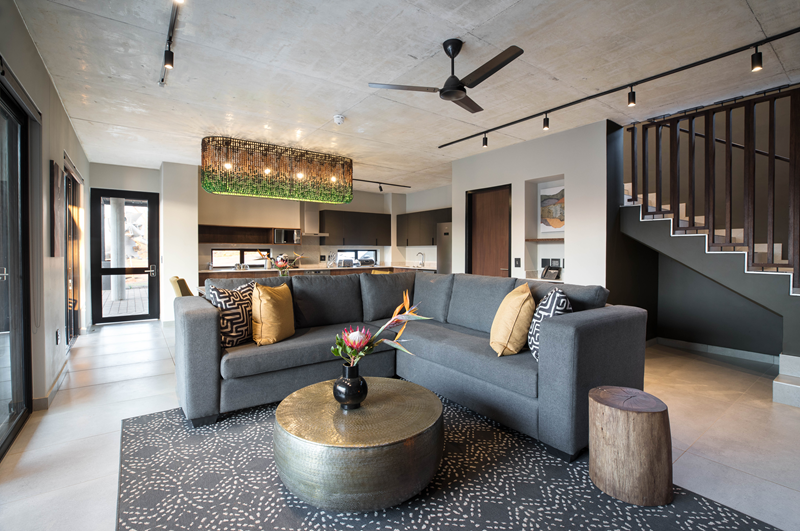
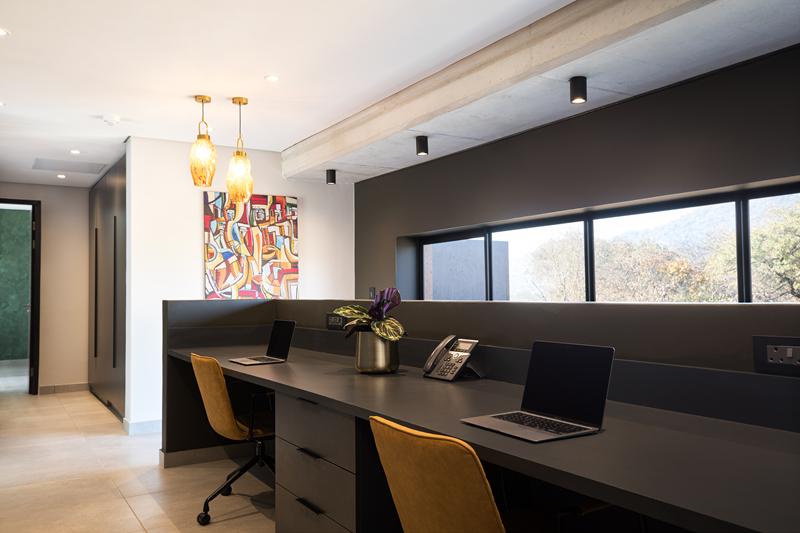
Sun City Resort’s sustainability manager, Lwazi Mswelanto, says, “As part of our water conservation efforts, wastewater from Lefika ablution and bathroom facilities will be treated using the resort’s Wastewater Treatment Plant, and will be recycled into grey water and used for irrigation all around Lefika Villas. In this way, we will achieve a significant saving on freshwater that would otherwise have to be used for irrigation. Currently, the resort treats about 2-millions litres of water which is re-used for irrigating gardens and the two golf courses.
“Furthermore, the grid tied solar installation feed includes Lefika, as solar energy can be directed across resort as needed.”
Lwazi adds that waste from Lefika will be collected and sorted at Sun City resort’s waste recovery yard. All recyclable waste will be recycled, and food waste be processed into compost using the Biobin technology.
Key statistics
- 100% South African suppliers and 95% South African products were used, making Lefika Villas proudly South African
- 13 local fine artists’ work have been used in the reception and villas
- 1 168 contractors were on site during construction
- A 30% local spend percentage has been maintained by using approximately 50 subcontractors, service providers, and local labour
- Materials used for the first phase include 2.2 million bricks, 4 200 m³ concrete, and 370 tonnes of steel.


